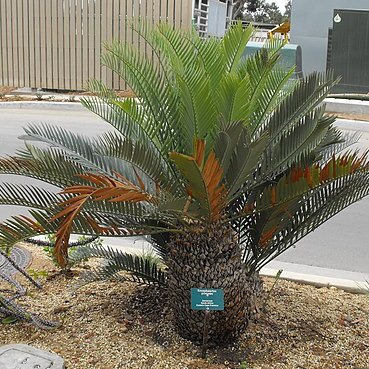Plant unbranched or more often branched from the base with stems up to 3 m tall or some attaining 4 m when reclining or procumbent, about 30 cm diam. Leaves 1-1.3 m long including petiole 15-20 cm long, glabrous, glaucous when young becoming dark green with age; rhachis straight for the most part with recurved and occasionally somewhat twisted apex, and the tomentose pulvinus mostly hidden by stem bracts; leaflets spaced in the lower half of the leaf and reduced in size towards the base, often overlapping in the upper half of the leaf and in V disposition; median leaflets up to about 15 cm long and 1.3 cm broad, pungent, entire or very occasionally toothed on lower margin. Cones 2 or more per crown, dull green, on short stout peduncles. Male cones subcylindric, narrowing to base and apex, 16-26 cm tall, 8-10 cm diam.; median scales about 3 cm long, 1.5-1.8 cm broad, 8-10 mm thick vertically; bulla face projected into a 1.2-1.5 cm long beak with sharp lateral ridges, terminal facet 5-8 mm broad and 4-6 mm wide vertically. Female cones more or less barrel-shaped, about 30 cm long and 20 cm diam., with rounded apex; median scales 6-7 cm long, 4-4-5 cm broad, 3-3.5 cm thick vertically, with lateral angles extending into lateral incurved lobes 1-1.5 cm long; bulla protruding 1.5-2 cm, flattened on the face, upper and lower facets rounded or indistinctly ridged, coarsely and irregularly warty or coarsely papillate and with thin tomentum of whitish or brownish hairs, terminal facet slightly below centre, rather variable in size, 5 mm-1.5 cm broad and 0.5-1 cm wide vertically, rugose, concave with raised rim. Seeds red, angled by compression, 4-5 cm long, 2 cm diam., fleshy beak about 1.5 cm long.
More
Plant dioecious, palm-like. Stem aerial or decumbent, 0.5-3.5 m long, unbranched or branched from base, covered by alternating series of woody bracts and persistent, swollen, truncated leaf bases. Leaves petiolate, pinnate with rachis recurved; median leaflets entire, pungent-pointed; reduced in size towards base of rachis. Cone Feb.-Dec., single, appears sessile, pale green. Male cone lanceoloid. Female cone cylindric to ovoid, broader than male, facets markedly verrucose, central facet raised.


